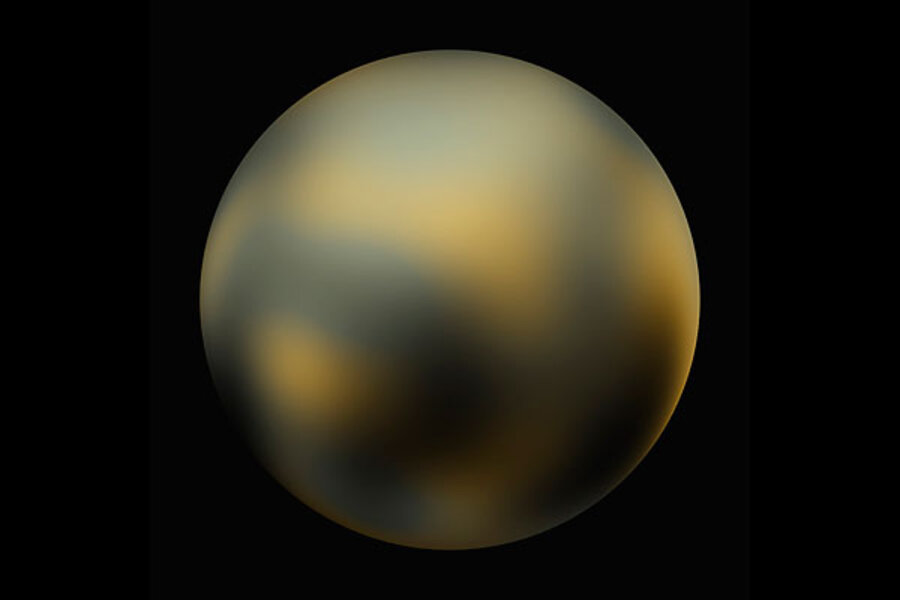New Hubble images reveal Pluto's dynamic surface
Loading...
The dwarf planet Pluto has gone yellow camo.
New images of the distant ice ball captured by the Hubble Space Telescope and released Thursday reveal a sphere swathed in muted blotches of black, charcoal, white, and yellow-orange.
The colors testify to the nitrogen, methane, and carbon monoxide that are the prime ingredients in Pluto's ices and its faint wisp of an atmosphere.
The images – the most detailed yet taken of Pluto – reveal a surface that is among the most dynamic in the solar system.
The new images, gathered between 2002 and 2003 and processed over the past seven years, also show large differences in surface features compared with images taken in 1994, explained Mike Brown, an astronomer at the California Institute of Technology at a NASA briefing Thursday.
On Earth, "ice caps come and go; there's Mars, where ice caps come and go," he says. "Then there's Pluto. You're looking at the surface in the solar system that has the biggest changes of anything we're ever seen."
These changes appear in some images as the morphing of dark and light patches across the surface over time, and may be linked to the changing seasons on Pluto, researchers say. Pluto’s trip around the sun takes 248 years. So one would expect the march of the seasons to be closer to a snail's pace.
“But it's a little bit of a surprise to see this big a change this fast,” in surface features as well in as other aspects of Pluto's appearance, says Marc Buie, a planetary scientist at the Southwest Research Institute in Boulder, Colo., and the lead scientist on the project.
The colors in the composite images represent "my best guess of what the true-color appearance would be if you were sitting in your spacecraft floating around Pluto," Dr. Buie says.
The view is similar to the one humans get of the moon with the naked eye, he says. There's not enough detail to pick out individual mountains or craters, but enough to suggest significant differences in surface features.
Images will help plan for fly-by
The new images of what was once the solar system's ninth planet come as NASA's first mission to Pluto, New Horizons, has passed the half-way point in its trip to Pluto and at least one other object beyond in the Kuiper Belt – a region that begins just beyond Neptune and reaches deep into the outer solar system.
Launched Jan. 16, 2006, the spacecraft is on track for a flyby of Pluto and its companion Charon. The craft will achieve its closest approach to the pair on July 14, 2015.
Indeed, the new Hubble images already are helping the New Horizons team plan its observations during the flyby, Buie says.
Pluto is the key destination on the spacecraft's trip. But a fly-by allows for no do-overs. So the encounter is carefully choreographed. The Hubble images, along with others gathered by ground and space-based telescopes over the next five years, will help scientists lay out a careful time line of commands that the craft will use to ensure the right instruments are aimed at the right places at the right times.
Images took seven years and 20 computers
To build the new portraits of Pluto, Buie's team gathered 384 Hubble images of the dwarf planet between 2002 and 2003. But in each image, Pluto appears only as a tiny dot of light. So the team employed a technique called “dithering” to generate images slightly offset from each other. The individual images emerged after seven years of processing on 20 homemade computers running in parallel.
In analyzing the images, Buie’s team see other changes in Pluto beyond shifting surface features.
Data gathered between 1954 and 2000 showed that Pluto's surface displayed a reddish tint – somewhere between the hue of Mars and Jupiter's moon Io, Buie says. That color remained virtually unchanged during that time. But the dwarf planet's average color during the period Buie and his team gathered their data was 20 to 30 percent redder.
The change might be hard to distinguish with the naked eye. But "it's a very marked change. Put it in the context of what the rest of the solar system's surfaces do,” this rate of change is “unprecedented,” he says.
---
Follow us on Twitter.





